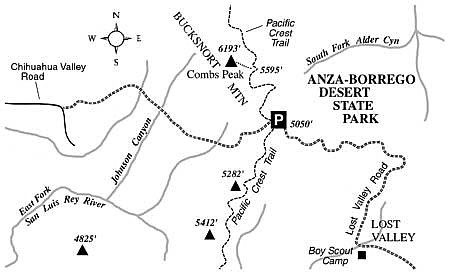 Facebook
Facebook
 X
X
 Instagram
Instagram
 TikTok
TikTok
 Youtube
Youtube
The northernmost stretch of the Pacific Crest Trail (PCT) in San Diego County traverses the flank of the colorfully named Bucksnort Mountain. Combs Peak is the highest summit on that mountain ridge, and rates as one of the highest elevations within the county. To reach the top you must be prepared for some off-trail, cross-country hiking.
The getting-there-by-car phase is a mini-adventure in itself. From Highway 79, 11 miles north of Warner Springs, turn east on Chihuahua Valley Road. Go 6.3 miles east to a sharp right bend in the paved road. Straight ahead at that juncture is unpaved Lost Valley Road (bumpy but normally suitable for ordinary cars), leading 10 miles to the Lost Valley Boy Scout Camp. Drive for about 5 miles on this road and look for the place where the PCT crosses the road. There's space to park on the left, and a sign indicating distances northward along the Pacific Crest Trail.
From your parking spot, follow the PCT as it wends its lazy way gradually uphill through scattered chaparral, most of which has been singed in recent wildfires. Some fire-following wildflowers, such as lupine, may be in bloom depending on the amount of recent rainfall. Rocks strewn about the trail sparkle with sunlight reflected from the large mica crystals within them. The ridgeline of Bucksnort Mountain on the left is bewhiskered with the blackened trunks of thoroughly incinerated Coulter pines. This stark scene is mirrored by the spacious and completely empty (as it appears from here, anyway) terrain of the Anza-Borrego Desert on the right and below.
After 2.7 miles of walking on the PCT, you'll come to a crest on the east shoulder of Combs Peak. From this point, leave the PCT and simply go uphill through the chaparral vegetation in the most direct manner possible, following a rough route worn in by hikers. The way is marked somewhat obscurely by "ducks" -- small piles of stones placed as trail markers by hikers.
After considerable huffing, puffing, and foot sliding, you stand upon Combs Peak, which overlooks many mountain ranges and valleys in the northern San Diego County/southern Riverside County region. Most impressive, perhaps, is the great wall of the Santa Rosa Mountains just east, culminating at 8716-foot Toro Peak. Lost in the reverie of the view, you may be startled by the sudden "whoosh" of a sailplane sneaking up behind you and barely clearing the peak.

The quickest way to get back is by the same route. Take care when negotiating the sometimes-slippery slope that takes you back down to the PCT.
This article contains information about a publicly owned recreation or wilderness area. Trails and pathways are not necessarily marked. Conditions can change rapidly. Hikers should be properly equipped and have safety and navigational skills. The Reader and Jerry Schad assume no responsibility for any adverse experience.

The northernmost stretch of the Pacific Crest Trail (PCT) in San Diego County traverses the flank of the colorfully named Bucksnort Mountain. Combs Peak is the highest summit on that mountain ridge, and rates as one of the highest elevations within the county. To reach the top you must be prepared for some off-trail, cross-country hiking.
The getting-there-by-car phase is a mini-adventure in itself. From Highway 79, 11 miles north of Warner Springs, turn east on Chihuahua Valley Road. Go 6.3 miles east to a sharp right bend in the paved road. Straight ahead at that juncture is unpaved Lost Valley Road (bumpy but normally suitable for ordinary cars), leading 10 miles to the Lost Valley Boy Scout Camp. Drive for about 5 miles on this road and look for the place where the PCT crosses the road. There's space to park on the left, and a sign indicating distances northward along the Pacific Crest Trail.
From your parking spot, follow the PCT as it wends its lazy way gradually uphill through scattered chaparral, most of which has been singed in recent wildfires. Some fire-following wildflowers, such as lupine, may be in bloom depending on the amount of recent rainfall. Rocks strewn about the trail sparkle with sunlight reflected from the large mica crystals within them. The ridgeline of Bucksnort Mountain on the left is bewhiskered with the blackened trunks of thoroughly incinerated Coulter pines. This stark scene is mirrored by the spacious and completely empty (as it appears from here, anyway) terrain of the Anza-Borrego Desert on the right and below.
After 2.7 miles of walking on the PCT, you'll come to a crest on the east shoulder of Combs Peak. From this point, leave the PCT and simply go uphill through the chaparral vegetation in the most direct manner possible, following a rough route worn in by hikers. The way is marked somewhat obscurely by "ducks" -- small piles of stones placed as trail markers by hikers.
After considerable huffing, puffing, and foot sliding, you stand upon Combs Peak, which overlooks many mountain ranges and valleys in the northern San Diego County/southern Riverside County region. Most impressive, perhaps, is the great wall of the Santa Rosa Mountains just east, culminating at 8716-foot Toro Peak. Lost in the reverie of the view, you may be startled by the sudden "whoosh" of a sailplane sneaking up behind you and barely clearing the peak.

The quickest way to get back is by the same route. Take care when negotiating the sometimes-slippery slope that takes you back down to the PCT.
This article contains information about a publicly owned recreation or wilderness area. Trails and pathways are not necessarily marked. Conditions can change rapidly. Hikers should be properly equipped and have safety and navigational skills. The Reader and Jerry Schad assume no responsibility for any adverse experience.
Comments